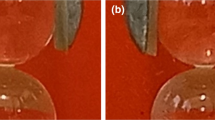Abstract
The special features of the processes that occur in ceramic materials fracturing in a wide temperature range are considered. It is shown that the brittleness of these materials is explainable by the special features of their crystalline structure. For the same reasons they exhibit plasticity only in the range of high temperatures. General problems of the strength of ceramics are considered from the standpoint of synergetics, which studies the processes of time-and-space ordering and self-organization in nonequilibrium systems.
Similar content being viewed by others
References
V. S. Bakunov and A. V. Belyakov, “Thermal stability and structure of ceramics,”Izv. Ros. Akad. Nauk, Neorg. Mater.,33(12), 1533–1536 (1997).
V. S. Bakunov and A. V. Belyakov, “To the problem of analyzing the structure of ceramics,”Izv. Ros. Akad. Nauk, Neorg. Mater.,32(2), 243–248 (1996).
H. Haken,Synergetics, Springer, Heidelberg (1978).
V. S. Ivanova, A. S. Balankin, I. Zh. Bunin, et al.,Synergetics and Fractals in Materials Science [in Russian], Nauka, Moscow (1994).
Encyclopedia of Physics, Vol. 3 [in Russian], Bol'shaya Ros. Éntsiklopediya, Moscow (1992).
V. S. Bakunov, V. L. Balkevich, I. Ya. Guzman, et al.,A Practical Course on the Chemical Technology of Ceramics and Refractories [in Russian], Stroiizdat, Moscow (1972).
H. Van Bueren,Imperfections in Crystals, Amsterdam (1960).
W. D. Kingery,An Introduction to Ceramics [Russian translation], Strolizdat, Moscow (1964).
G. V. Samsonov (ed.),Physicochemical Properties of Oxides, A Reference Book [in Russian], Metallurgiya, Moscow (1978).
S. M. Barinov and V. Ya. Shevchenko,Strength of Technical Ceramics [in Russian], Nauka, Moscow (1996).
G. Nicolis and I. Prigogine,Self-Organization in Nonequilibrium Systems, Wiley, New York (1980).
W. D. Kingery,High-Temperature Measurements [Russian translation], Metallurgiya, Moscow (1963).
V. G. Bar'yakhtar and A. A. Galkin, “On the transition of solid bodies from a brittle to a plastic state,”Dokl. Akad. Nauk SSSR 227(5), 1079–1081 (1976).
S. M. Barinov and Yu. L. Krasulin, “On the transition of ioniccovalent crystals to a plastic state,”Dokl. Akad. Nauk SSSR,242(6), 1314–1320 (1978).
S. M. Barinov and Yu. L. Krasulin, “Interrelation between the energy of formation of a vacancy and the temperature of the transition to a plastic state in crystals with a diamond structure,”Fiz. Khim. Obrab. Mat., No. 3, 158–159 (1979).
J.-P. Puarieu,Creep in Crystals [Russian translation], Mir, Moscow (1988).
P. Yu. Butyagin, “Problems and prospects of mechanochemistry,”Usp. Khim.,63(12), 1031–1043 (1994).
E. A. Varentsov and Yu. A. Khrustalev. “Mechanochemistry and mechanoemission of molecular organic crystals,”Usp. Khim.,64(8), 834–849 (1995).
A. V. Belyakov, “Manufacture of ceramics for basic engineering,” in:News of Science and Engineering. Production of Silicate and Refractory Nonmetallic Materials, Vol. 1 [in Russian], VINITI, Moscow (1988), pp. 3–71.
S. G. Tresvyatskii,Structure and Strength of Brittle Polycrystal-line Materials, Preprint ONTI IPM AN UkrSSR [in Russian], Kiev (1971).
E. S. Lukin, “Modern high-density oxide ceramics with a controlled microstructure. Part III. Choice of modifying additives that affect the degree of sintering of oxide ceramics,”Ogneupory Tekh. Keram., No. 4, 2–13 (1996).
Author information
Authors and Affiliations
Rights and permissions
About this article
Cite this article
Bakunov, V.S., Belyakov, A.V. Strength and structure of ceramics. Refractories and Industrial Ceramics 39, 86–90 (1998). https://doi.org/10.1007/BF02767984
Received:
Issue Date:
DOI: https://doi.org/10.1007/BF02767984




